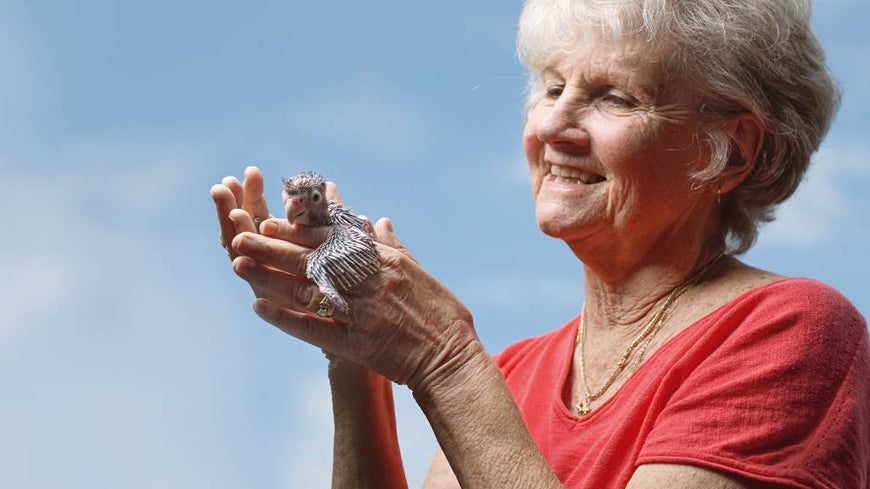The dedicated volunteers saving injured birds

Written by Beverley Hadgraft for Australian Seniors.
Australia is blessed with some of the most colourful and clever birds in the world. Here are some ways to help native birds that become injured, sick, or orphaned.
- Monitor from a distance: Bird breeding season, around spring and summer, is always a busy time for wildlife carers, but not every bird needs help. If a baby bird looks well-feathered, is standing well, and running or hopping to develop its flight muscles, just monitor it from a distance; its parents may well be around.
- Be gentle: If you find an injured bird, wrap it gently in a towel or blanket and put it into a ventilated cardboard box or carrier and take it to a vet. You won’t be charged. Make sure you tell the vet where you found it, so it can be returned to the same area if necessary.
- Check for parents: Territorial parents such as magpies or noisy miners generally stay close to babies, but parrots such as lorikeets, often get separated. If you find a baby parrot, contact a wildlife rescue group for advice. Baby brush turkeys are never orphaned – they’re independent from the day they’re born.
- Know your local wildlife group: If you see a sick or orphaned raptor or bird of prey such as an owl or eagle, keep your distance and contact your local wildlife rescue service as soon as possible. For details of your local wildlife group, search the database at Australian Fauna Care.
- Don’t give food: Don’t offer food or water to a sick or injured bird as feeding an animal in shock can be fatal, as can feeding it the wrong food. Stress can also be fatal so don’t handle the animal unnecessarily, and keep noise down.
- Cats can kill: Pet cats kill 61 million native birds a year, so keep them inside – if not possible all the time, at least at night. All birds that have been attacked by a cat need vet attention, due to the bacteria cats carry.
- Donate: You can donate unwanted aviaries or cages to your local animal rescue group, or make a money donation to help them with feed.
- Get advice: More advice is available from Wildcare Australia and WIRES.
The Gold Coast retiree who cares for birds at her home

When a tree is felled and an awful discovery is made – it contains a nest with eggs in it – there was once no hope for the baby birds. Now if the eggs can be delivered to a carer like Dianna Smith, she can help.
Five years ago, Dianna, 75, a volunteer with Wildcare Australia, was given an egg incubator. Among the 30 hatchlings she’s watched emerge since are lorikeets, welcome swallows, and tawny frogmouths.
It was a leap of faith to release her first babies back into the wild. “We presume a bird has to be taught what to eat and to fly by its parents but there’s so much instinct involved.” Her babies will venture further and for longer from her aviaries each day, she says, until they know they’re ready to look after themselves.
Dianna, a retired physiotherapist on the Queensland Gold Coast, became a carer 15 years ago after visiting a local show and spotting a stand for Wildcare, which rescues, rehabilitates and releases native wildlife. After receiving training and orientation, and performing basic rescues, she was given a permit to keep wildlife herself.
“I originally thought that looking after cute furry animals like kangaroos or koalas would be good,” she says. “But I’ve become more involved with birds. I really like them and they’re also a bit easier. I’ve looked after possums and bandicoots but if you have them as babies, they have to be fed at intervals 24 hours a day. Birds go to sleep as soon as the sun goes down and I value my sleep!”
It’s still a big commitment. “If you have a baby bird in your care, it depends on you to survive. You can’t take an afternoon off to go to the movies or visit a friend. Small birds may need to be fed every 15 minutes.”
If you can't save all wildlife, protect dogs and cats at home with Seniors Pet Insurance
26 Apr 2021